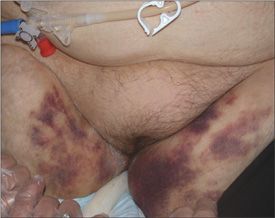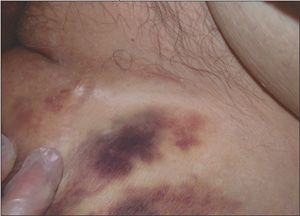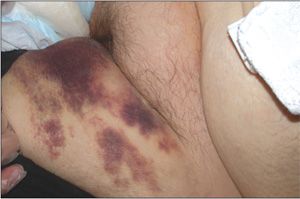- Clinical Technology
- Adult Immunization
- Hepatology
- Pediatric Immunization
- Screening
- Psychiatry
- Allergy
- Women's Health
- Cardiology
- Pediatrics
- Dermatology
- Endocrinology
- Pain Management
- Gastroenterology
- Infectious Disease
- Obesity Medicine
- Rheumatology
- Nephrology
- Neurology
- Pulmonology
Profoundly Impaired Woman With Bilateral Unexplained Upper-Thigh Bruises
Asked to evaluate bilateral unexplained upper-thigh bruises on a profoundly impaired woman newly admitted to our rehabilitation unit 2 weeks after an intracerebral hemorrhage. Patient received high-dose dexamethasone to reduce perihemorrhage edema.

HISTORY
Asked to evaluate bilateral unexplained upper-thigh bruises on a profoundly impaired woman newly admitted to our rehabilitation unit 2 weeks after an intracerebral hemorrhage. Patient received high-dose dexamethasone to reduce perihemorrhage edema.
A percutaneous gastrostomy was performed and is being used to administer nutrition, fluids, and medications.
Accompanying paperwork from the referring institution makes no mention of bruises. No known coagulopathy or thrombocytopenia; no warfarin or aspirin in the 2 weeks since her hemorrhagic stroke.
PHYSICAL EXAMINATION
Vital signs normal. Unresponsive verbally. Left gaze preference. Dense right hemiparesis with apparent hemianesthesia. Upgoing toe on right. Upper thighs as shown; no perianal or vulvar ecchymosis, and no ecchymoses elsewhere on the body.
WHAT'S YOUR DIAGNOSIS?
(Answer on next page.)
ANSWER: A MARK OF THE ICU
Nursing staff worried that this patient had a bleeding diathesis. We noted that both upper medial thighs contained abundant fresh ecchymosis without a breach in the skin surface. Most of the hematomas were deep purple, but there was some yellow-brown around the edges. Sparse powder was seen in the right inguinal crease and adjacent thigh, applied to counteract sweat-related maceration.
No 3-dimensional hematoma was palpable deep to any surface discoloration. There was no feature that suggested inflammation: no redness, heat, discernible tenderness, or local swelling. The vulva and the mons pubis were spared, as were the lateral thighs and remainder of the abdomen, so we considered a retroperitoneal source very unlikely.1-3
We considered the possibility of iatrogenic puncture lesions, despite the absence of any such mention in the medical records available to us. However, a careful search revealed no puncture wound, whether fresh or healing (Figure 1); this seemed to exclude vascular catheterization or femoral venipuncture.

REASONING ON THE SPOT AND THE EVER VALUABLE HISTORY
Because there were no foci of bleeding elsewhere on the patient's body, and because we had never seen thrombocytopenia or coagulopathy produce isolated bifemoral hematomas, we concluded that an unknown factor--possibly trauma--was involved. Despite the expected low yield, immediate tests were ordered: platelet count, INR, and activated partial thromboplastin time (aPTT); all had normal results.
Definitive enlightenment occurred when we made initial contact with the patient's daughter by telephone a few minutes later. She described multiple unsuccessful attempts to place central venous lines via the femoral approach. She had been terribly upset by the disfiguring ecchymoses that resulted, notwithstanding that the only medical complication was bleeding that required transfusion of 1 unit of packed red blood cells. Armed with this knowledge, we made a diagnosis of iatrogenic hematomas from attempted placement of a triple lumen catheter in each femoral vein. We also marveled that the punctures had healed to the point of invisibility in just 7 days, even though the patient had been nutritionally compromised, febrile, and critically ill for most of that time.
ALTERNATIVE CAUSES: FAMILIAR AND RARE
Elder abuse always deserves consideration in a bruised aged person who cannot speak for himself or herself.4-6 Furthermore, selective traumatic ecchymoses in the area shown are virtually unknown, because the area is all soft tissue, with bone only very deep beneath a thick cloak of muscle. This also explains why bedsores at this site are unheard of.
While one might infer that the bruises were chiefly fresh, the presence of brown at the margins would seem to imply an older event (Figure 2). However, a descriptive study with impeccable methodology showed that such change in color can occur even on the first day of the bruise and that some first-day bruises are already predominantly yellowed.7

Previous columns in this series have addressed bruising attributable to amyloid,5 thrombocytopenia,8 and scurvy,9 and we will not review this material further here.
MARK OF HOSPITAL VERSUS MARK OF CRITICAL CARE
Every clinician knows that extensive ecchymoses of the forearms and hands are expected in an aged person who has spent more than a day in an emergency department or hospital. These result from both phlebotomy and repeated intravenous line placements, with or without failed "sticks" and with or without overt clinical infiltration of the line. Many a patient loudly laments these bruises on a first post-hospital outpatient visit or in the skilled nursing facility to which he or she transfers for rehabilitation and reconditioning after an acute hospital stay. If the patient has been in a critical care unit, ecchymoses are even more numerous, because more lines are placed and more blood specimens drawn. One typically reassures such a patient that these bruises do not indicate any internal disorder and that they will fade and disappear, no matter how unsightly.
The present case illustrates another kind of bruising more particular to a critical care unit. Manifestly, the consequences of the failed venous catheterizations at these sites were not grave, as would be the case with a pneumothorax or hemothorax from the parallel problem at the subclavian site. In fact, the family recounted that after the failed attempts, a surgeon was consulted who placed a left subclavian catheter without difficulty; that site was marked by tiny, clean healing puncture wounds and no ecchymoses.
WHAT CAN BE LEARNED?
Foremost, this case underscores yet again the primacy of the history in helping us make sense of even a bizarre physical finding that was unprecedented in our experience.
Second, we note the failure of written documents to record the bruises, whether from haste, sloppiness, or fear of liability. That means that in obtaining collateral history, when the patient is unable to provide history herself, we cannot afford to consider the chart--or whatever portion of the chart reaches us--as conclusive and comprehensive. If confronted with a finding that cannot readily be explained, one needs to telephone the appropriate parties--whether nursing staff, previous physicians, APRNs and PAs, families, or some combination. However trite this may sound, it is the important step that is most often omitted.
Third, this case vividly demonstrates the hazards of the acute (nongeriatric) hospital for the aged patient. This phenomenon, which has been carefully documented in the study by Creditor,10 is well recognized for the general acute hospital but is less discussed in regard to critical care. However, many geriatricians, internists, and intensivists would concur that the ICU is especially disorienting to the aged demented person, and that it is associated with delirium, nosocomial infection, and other morbidities that undercut the immense benefits such units can confer.
Fourth, the emotional distress that the lesion caused the family, while not physical, was very real. This type of distress, whether in the patient or the family, tends to be overlooked in the plethora of concerns that surround a very ill patient.
A minor coda is the extraordinary but nonuniform capacity of patients to heal wounds even when desperately ill. Good sterile technique was part of the practice at the femoral punctures, and the defect in the epithelium was small; nevertheless, considering how much blood leaked out, and how this should delay and impede healing, the disappearance of the puncture marks remains surprising--all the more so because the puncture from successful subclavian catheterization had not disappeared! *
Schneiderman H, Ver SF. A mark of the ICU: severe bilateral thigh hematomas from failed placement of triple-lumen femoral catheters. CONSULTANT. 2007;47:97-103.
References:
REFERENCES:
1.
Schneiderman H. Peculiar striped penile hematoma and local "doughnut hematoma" after transfemoral coronary angioplasty.
Consultant.
1999;39: 2801-2809.
2.
Schneiderman H. Follow-up: hematomas fade and resolve.
Consultant.
1999; 39:3350.
3.
Iloeje UH, Schneiderman H. Nontraumatic penoscrotal hematoma due to leakage from abdominal aortic aneurysm.
Consultant.
1996;36:2023-2025.
4.
Schneiderman H, Esstman E, Baker D, Gottschalk M. Severe facial ecchymoses, and the recognition and distinctions of multifactorial falls.
Consultant.
2004;44:619-630.
5.
Lane S, Grzhibek M, Schneiderman H. Amyloidosis in the skin and the mouth: periocular differentials illuminated by logic and coexistence of macroglossia.
Consultant.
2006;46:1065-1070.
6.
Schneiderman H. Conjunctival and orbital ecchymosis, either spontaneous or from occult trauma.
Consultant.
2004;44:93-100.
7.
Mosqueda L, Burnight K, Liao S. The life cycle of bruises in older adults.
J Am Geriatr Soc.
2005;53:1339-1343.
8.
Schneiderman H. Oral blood blisters with severe thrombocytopenia, and bedside assessment of bleeders.
Consultant.
1992;32(4):131-132.
9.
Schneiderman H. Perifollicular hemorrhages due to scurvy (vitamin C deficiency) in an American alcoholic.
Consultant.
1991;31(1):49-50.
10.
Creditor MC. Hazards of hospitalization of the elderly.
Ann Intern Med.
1993;118:219-223.
